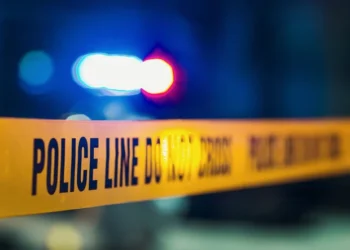John Allan Chapman was raised in Windsor Locks, Connecticut. He was the son of Eugene and Terry and brother to Lori, Tammy, and Kevin. According to accounts of his early life, John was quick to defend the underdogs among his classmates and friends. At Windsor Locks High School he excelled at sports, making the varsity soccer squad as a freshman. He also was very mechanically inclined, and as a muscle-car enthusiast, he rebuilt a classic Pontiac GTO that became his signature ride.
John graduated in 1983, and two years later enlisted in the Air Force where he was initially trained as an information systems operator. He was assigned to the 1987th Information Systems Squadron at Lowry Air Force Base, Colorado, for three years. Per his goal, he then spent two years cross-training to become a Combat Controller. That involves rigorous physical fitness training with multiple joint military operations schools, including Navy SCUBA and Army static-line and freefall parachute training.
Air Force Combat Controllers are elite “special tactics operators” working with Army Special Forces, Marines, and Navy SEALs primarily in covert, forward, and austere combat environments. They specialize in all aspects of air-ground communication, air traffic control, close air fire support, and command and control communications.
Only about one in 10 Airmen make it through Combat Controller training, and as John’s instructor Ron Childress observed: “One remembers two types of students — the sharp ones and the really dull ones — and Chapman was in the sharp category. During one of his first days at Combat Control School, I noticed a slight smirk on his face like [the training] was too simple for him … and it was.”
John was specifically trained as a fast deployment operator capable of infiltrating deep into enemy territory. After Combat Control School, then-Sergeant Chapman served with the 1721st Combat Control Squadron at Pope Air Force Base, North Carolina.
It was there he met his wife Valerie in 1992. They had two daughters, Madison and Brianna, whom he cherished. Val says: “The first time he held Madison, the spark in his eye was like nothing I’d seen before. It was like a kid in a candy store, he was so excited.” Though balancing home life amid his demanding job, she ads: “When he was home, he was home. He could have killed 5,000 people at work and, when he walked in the door, you’d never have known.”
John had planned to separate from the service in 2002, until the 9/11 Islamist attack on our nation changed his mind. At the time, he said, “My job now is to serve my country, but there’s a greater thing than that. When this war is over, I’m going to dedicate myself to my family.”
It was with the 24th Special Tactics Squadron, deployed from Pope AFB to Afghanistan for Operation Enduring Freedom a year later, that John would distinguish himself as an operator.
In conjunction with Operation Anaconda in March 2002, he and his joint special operations teammates, including Navy SEAL Master Chief Petty Officer Britt Slabinski, whom I have previously profiled, were assigned to establish a reconnaissance position on Takur Ghar and report al-Qa’ida movements in the region.
Retired Air Force Col. Ken Rodriguez, John’s commander at the time, recalled: “This was a very high-profile, no-fail job, and we picked John. In a very high-caliber career field, with the highest quality of men — even then — John stood out as our guy.”
The mission in the darkness of the early morning of 4 March was plagued with problems from the start.
The MH-47 Chinook helicopter carrying Chapman and his reconnaissance team to their mountaintop position was ambushed by enemies armed with RPGs and machine guns, and it was forced to make a controlled crash landing a few miles from the initial point of contact. But as the helicopter veered to avert fire, Navy SEAL Neil Roberts fell off the ramp to the frigid ground below amid the enemy. Thus began a series of events that would result in the deaths of seven U.S. servicemen and the awarding of two Medals of Honor, one to Slabinski and a posthumous award to Chapman.
According do the Department of Defense account: “Petty Officer Roberts was in desperate need of support. The remaining joint special operations team members, fully aware of his precarious situation, immediately began planning a daring rescue attempt that included returning to the top of Takur Ghar where they had just taken heavy enemy fire. As the team returned to Petty Officer Roberts’ last-known position, now on a second MH-47, the entrenched enemy forces immediately engaged the approaching helicopter with heavy fire. Miraculously, the helicopter, although heavily damaged, was able to successfully offload the remaining special operations team members and return to base. Chapman, upon exiting the helicopter, immediately charged uphill through the snow toward enemy positions while under heavy fire from three directions.”
Once on the ground, the team assessed the situation and moved quickly to the high ground. The most prominent cover and concealment on the hilltop was a large rock and a tree. As they approached the tree, Chapman received fire from two enemy personnel in a fortified position. He returned fire, charged the enemy position, and took out the enemy combatants within.
Almost immediately, the team began taking machine gun fire from another fortified enemy position only 12 meters away. TSgt Chapman deliberately moved into the open to engage the new enemy position. As he heroically engaged the enemy, he was struck by a burst of gunfire and became critically injured.
He regained his faculties and continued to fight relentlessly despite his severe wounds. He sustained a violent engagement with multiple enemy fighters for over an hour, until the arrival of the quick reaction force, before paying the ultimate sacrifice. In performance of these remarkably heroic actions, John is credited with saving the lives of his teammates.
In all, John sustained nine wounds, seven of which were nonfatal, and his wounds suggested that at some point during the battle, he engaged in close-quarters hand-to-hand combat.
For his actions, Chapman was posthumously promoted to Master Sergeant and awarded the Air Force Cross, the USAF’s second-highest military decoration.
It was a long time coming, but after much lobbying by more than 20 of his fellow service members whose lives he was instrumental in saving, John Chapman’s Air Force Cross was upgraded to a Medal of Honor. On August 22, 2018, President Donald Trump awarded his Medal to John’s widow, Valerie, on her late husband’s behalf.
According to his Medal of Honor citation, “By his heroic actions and extraordinary valor, sacrificing his life for the lives of his teammates, Technical Sergeant Chapman upheld the highest traditions of military service and reflected great credit upon himself and the United States Air Force.”
At the ceremony, President Trump remarked, “Our nation is rich with blessings, but our greatest blessings of all are the patriots … who, like John, carry our freedom on their shoulders, march into the face of evil, and fight to their very last breath so that we can live in freedom and safety and peace.”
Air Force Chief of Staff Gen David Goldfein added: “Tech. Sgt. John Chapman’s inspiring story is one of selfless service, courage, perseverance, and honor, and he represents all that is good, all that is right, and all that is best in our American Airmen. He is a true American hero.”
Indeed.
The circumstances of John’s death became the subject of controversy soon after his death because, in the fog of war, he was presumed dead and left behind during the urgent exfil. It was determined later from overhead video, physical evidence, and witness statements that he had, in fact, recovered consciousness and continued fighting. We believe each American Patriot involved in this battle acted with honor and bravery under dire circumstances, and we’re pleased to see both Slabinski and John Chapman awarded our nation’s highest medal for valor.
John Chapman was the first Airman to receive the Medal of Honor since the Vietnam War, and it was the first Medal awarded to a Special Tactics Airman. There have been 56 Medals of Honor presented to Army Air Force and Air Force members from World War I, World War II, the Korean War, and the Vietnam War, and this was the seventh Medal of Honor to be awarded to an enlisted Airman since the inception of the U.S. Air Force in 1947.
On his last morning at home with Valerie and his kids, as she dropped him off at the JSOC compound on Ft Bragg, she recalls, after a quick kiss, he said, “I’m out.” Valerie adds: “It was just business as usual for us. I didn’t realize it was the last time I was going to see him.” Those are words we should all take to heart.
MSgt John Chapman: Your example of valor — a humble American Patriot defending Liberty for all above and beyond the call of duty and in disregard for the peril to your own life — is eternal.
“Greater love has no one than this, to lay down one’s life for his friends.” (John 15:13)
Live your life worthy of his sacrifice.
(Read more Profiles of Valor here.)
Semper Vigilans Fortis Paratus et Fidelis
Pro Deo et Libertate — 1776
Follow Mark Alexander on X/Twitter.
Join us in daily prayer for our Patriots in uniform — Soldiers, Sailors, Airmen, Marines, and Coast Guardsmen — standing in harm’s way in defense of American Liberty, honoring their oath “to support and defend” our Constitution. Pray for our Veterans, First Responders, and their families. Please consider a designated gift to support the National Medal of Honor Sustaining Fund through Patriot Foundation Trust, or make a check payable to “NMoH Sustaining Fund” and mail it to:
Patriot Foundation Trust
PO Box 407
Chattanooga, TN 37401-0407
Thank you for supporting our nation’s premier journal of American Liberty.
The Patriot Post and Patriot Foundation Trust, in keeping with our our Military Mission of Service to our uniformed service members and veterans, are proud to support and promote the National Medal of Honor Heritage Center, the Congressional Medal of Honor Society, both Honoring Their Sacrifice Foundation and Warrior Freedom Service Dogs aiding wounded veterans, Tunnel to Towers Foundation, the National Veterans Entrepreneurship Program, the Folds of Honor outreach and Officer Christian Fellowship, the Air University Foundation and Naval War College Foundation, and the Naval Aviation Museum Foundation.

















